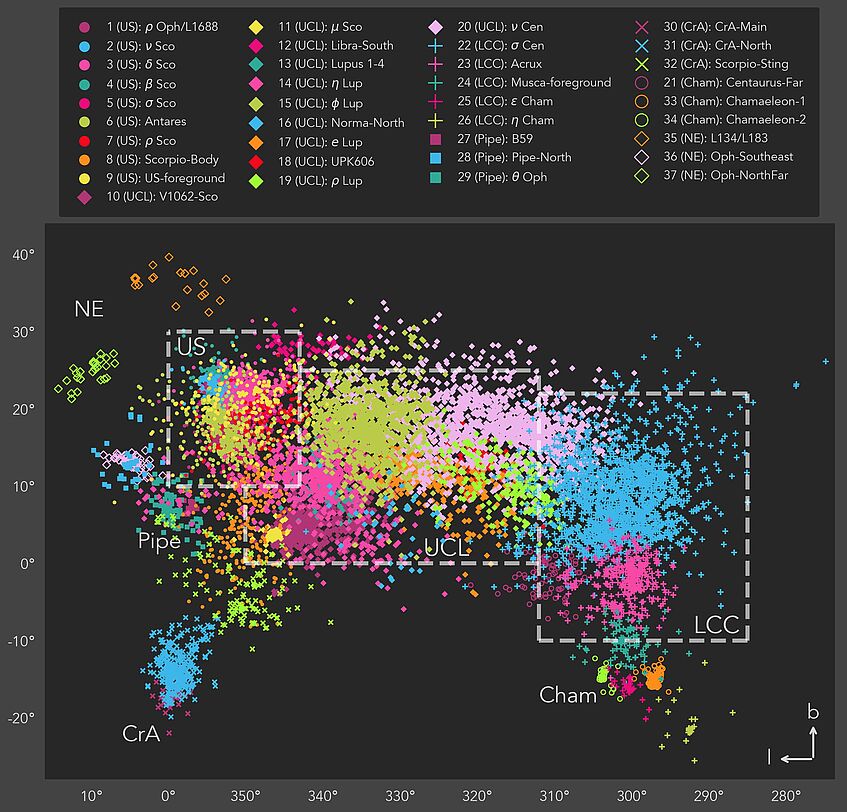Updated clustered 3D structure of Sco-Cen with SigMA
Significance Mode Analysis (SigMA) for hierarchical structures. An application to the Sco-Cen OB association
(Ratzenböck, Großschedl et al. 2023a)
In this work we study the Scorpio-Centaurus OB association and star-forming complex (Sco-Cen) to better understand the substructure (clusterings) of this nearby region that is located within 150 pc from the Sun.
In collaboration with Data Science @ Uni Vienna (Torsten Möller, Sebastian Ratzenböck) we have developed a novel unsupervised machine learning tool called SigMA (Significance Mode Analysis) published in Ratzenböck, Großschedl et al. (2023a). SigMA looks for over densities directly in the Gaia 5D phase space and is fine-tuned to find physically meaningful clusterings by identifying modal regions separated by dips in 5D, with a measure of significance. We find that SigMA is able to go beyond the state-of-the-art and is able to outperform recent clustering solutions that use the frequently used HDBSCAN tool (e.g., Kerr et al. 2021, 2023; Hunt & Reffert 2023) by finding more substructure and richer stellar populations in densely packed cluster environments like OB associations (tested on Sco-Cen and mock data).
The detailed analysis of Sco-Cen with SigMA revealed a complex clustered substructure, with 37 richly populated, co-moving, and co-eval stellar populations. Moreover, we find that it has a larger extent than earlier established (e.g., de Zeeuw et al. 1999, Pecaut & Mamajek 2016, Wright & Mamajek 2018, Damiani et al. 2019), confirming other recent work (e.g., Kerr et al. 2021). We find that the whole complex extends beyond the traditional borders (see Fig. 2 and the interactive figures 2D-ScoCen, 3D-ScoCen).
Traditionally, Sco-Cen was split into three subregions, Upper Scorpius (US), Upper Centaurus Lupus (UCL), and Lower Centaurus Crux (LCC), which are all located largely above the Galactic plane (see Fig. 2). The updated view shows that some clusters also extend below the Galactic plane. Moreover, this new view connects the stellar association to virtually all nearby molecular clouds in the Southern Hemisphere within 200 pc: Pipe, Corona Australis (CrA), Chamaeleon (Cham), Ophiuchus (Oph), Lupus, L134/L183, and Musca.
The challenging development of the SigMA tool and its application on Sco-Cen is of high value to the community and it will be an important legacy for scientists who work on similar fields of research. The cluster analysis of Sco-Cen revealed important knowledge about its structure and enabled a better understanding of its history, as followed up in Ratzenböck, Großschedl et al. (2023b) (see here).
The workload on Ratzenböck, Großschedl et al. (2023a) was split between Sebastian Ratzenböck (FFG Project FO999892674), leading the methodology part and the discussion of the performance of the clustering tool; and Josefa Großschedl, leading the analysis, astrophysical interpretation, comparison to the literature, and discussion parts.

Fig. 2. Distribution of the 37 clusterings in the Sco-Cen complex, as selected with SigMA, shown in projected Galactic coordinates (l,b in degrees). The traditional borders (see Blaauw 1964, de Zeeuw+1999) are indicated with dashed boxes. See also the interactive figures online 2D-ScoCen, 3D-ScoCen. Figure from Ratzenböck, Großschedl et al. (2023a).
